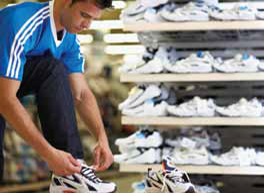
Given the wide range of running shoes on the market, you may wonder whether you need to buy the most current or expensive pair of shoes. A shoe is only as good as the protection it offers the runner. Because the plantar fascia, a thick connective tissue running along the sole of the foot, carries up to 14% of the total load of the foot, it seems sensible that running shoes should cushion the foot and protect the runner from injuries that affect knees, hips and the back. This is especially important because once injured, they can be difficult to rehabilitate.
However, a 2013 study from the Sports Medicine Research Laboratory in Luxembourg found no difference in injuries between runners who wore cushioned shoes and those who wore hard shoes. And a 2009 study published in the British Journal of Sports Medicine found no evidence that wearing cushioned shoes makes a runner less prone to injury. Early running champions ran in canvas shoes, their only shock absorption coming from the compression of their legs and the thick pad of midfoot fat. In fact, Arthur Lydiard, the most influential distance-running coach of all time, advocates wearing shoes that let your foot function like they’re barefoot. If you are in the market for a new pair of running shoes, here are some suggestions:
- Visit a specialty running shoe store.
- Have your feet measured for size every time you buy a new pair.
- Try the shoes on. The shoe should feel snug but not tight. Because feet swell and lengthen during a run, make sure there is a thumb’s width between your toe and the end of the shoe.
- Buy your shoes in the evening because your feet reach their greatest size by about 4 p.m.
- Avoid buying a shoe for looks or purchasing shoes that are too small.
- And when you are ready to pay, ask if there are any discounts available for running club members.
We can assess your foot and devise a progressive running program based on your age and level of fitness. We can create a “map” of your foot and determine the proper amount of cushion needed to support you consistently while you add up the miles.










